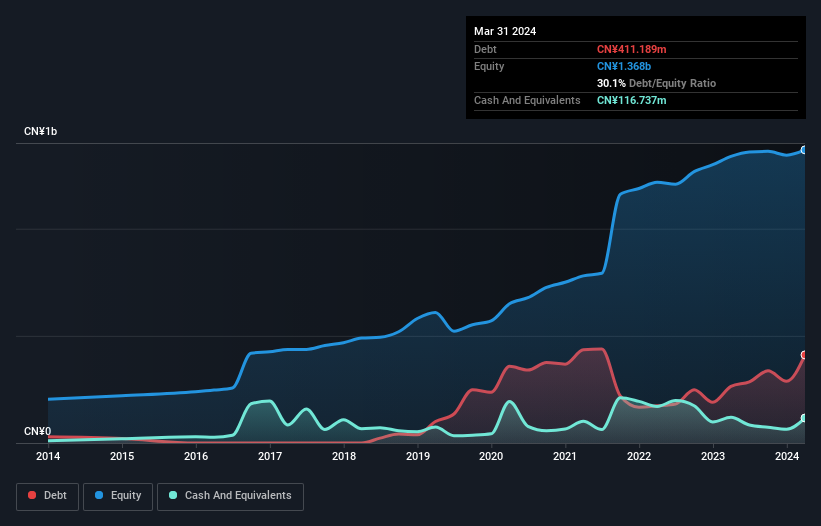Is Sanxiang Advanced Materials (SHSE:603663) A Risky Investment?
Warren Buffett famously said, 'Volatility is far from synonymous with risk.' So it seems the smart money knows that debt - which is usually involved in bankruptcies - is a very important factor, when you assess how risky a company is. We note that Sanxiang Advanced Materials Co., Ltd. (SHSE:603663) does have debt on its balance sheet. But the real question is whether this debt is making the company risky.
What Risk Does Debt Bring?
Debt and other liabilities become risky for a business when it cannot easily fulfill those obligations, either with free cash flow or by raising capital at an attractive price. Ultimately, if the company can't fulfill its legal obligations to repay debt, shareholders could walk away with nothing. However, a more frequent (but still costly) occurrence is where a company must issue shares at bargain-basement prices, permanently diluting shareholders, just to shore up its balance sheet. Of course, the upside of debt is that it often represents cheap capital, especially when it replaces dilution in a company with the ability to reinvest at high rates of return. When we examine debt levels, we first consider both cash and debt levels, together.
See our latest analysis for Sanxiang Advanced Materials
How Much Debt Does Sanxiang Advanced Materials Carry?
The image below, which you can click on for greater detail, shows that at March 2024 Sanxiang Advanced Materials had debt of CN¥411.2m, up from CN¥264.1m in one year. On the flip side, it has CN¥116.7m in cash leading to net debt of about CN¥294.5m.

How Strong Is Sanxiang Advanced Materials' Balance Sheet?
We can see from the most recent balance sheet that Sanxiang Advanced Materials had liabilities of CN¥689.5m falling due within a year, and liabilities of CN¥51.9m due beyond that. Offsetting this, it had CN¥116.7m in cash and CN¥474.8m in receivables that were due within 12 months. So it has liabilities totalling CN¥149.8m more than its cash and near-term receivables, combined.
Of course, Sanxiang Advanced Materials has a market capitalization of CN¥6.49b, so these liabilities are probably manageable. However, we do think it is worth keeping an eye on its balance sheet strength, as it may change over time.
We measure a company's debt load relative to its earnings power by looking at its net debt divided by its earnings before interest, tax, depreciation, and amortization (EBITDA) and by calculating how easily its earnings before interest and tax (EBIT) cover its interest expense (interest cover). Thus we consider debt relative to earnings both with and without depreciation and amortization expenses.
With a debt to EBITDA ratio of 2.2, Sanxiang Advanced Materials uses debt artfully but responsibly. And the fact that its trailing twelve months of EBIT was 9.2 times its interest expenses harmonizes with that theme. Shareholders should be aware that Sanxiang Advanced Materials's EBIT was down 63% last year. If that decline continues then paying off debt will be harder than selling foie gras at a vegan convention. When analysing debt levels, the balance sheet is the obvious place to start. But you can't view debt in total isolation; since Sanxiang Advanced Materials will need earnings to service that debt. So if you're keen to discover more about its earnings, it might be worth checking out this graph of its long term earnings trend.
Finally, a business needs free cash flow to pay off debt; accounting profits just don't cut it. So the logical step is to look at the proportion of that EBIT that is matched by actual free cash flow. Over the last three years, Sanxiang Advanced Materials reported free cash flow worth 12% of its EBIT, which is really quite low. That limp level of cash conversion undermines its ability to manage and pay down debt.
Our View
Sanxiang Advanced Materials's EBIT growth rate was a real negative on this analysis, although the other factors we considered cast it in a significantly better light. For example, its interest cover is relatively strong. Taking the abovementioned factors together we do think Sanxiang Advanced Materials's debt poses some risks to the business. While that debt can boost returns, we think the company has enough leverage now. The balance sheet is clearly the area to focus on when you are analysing debt. However, not all investment risk resides within the balance sheet - far from it. These risks can be hard to spot. Every company has them, and we've spotted 2 warning signs for Sanxiang Advanced Materials (of which 1 shouldn't be ignored!) you should know about.
Of course, if you're the type of investor who prefers buying stocks without the burden of debt, then don't hesitate to discover our exclusive list of net cash growth stocks, today.
New: Manage All Your Stock Portfolios in One Place
We've created the ultimate portfolio companion for stock investors, and it's free.
• Connect an unlimited number of Portfolios and see your total in one currency
• Be alerted to new Warning Signs or Risks via email or mobile
• Track the Fair Value of your stocks
Have feedback on this article? Concerned about the content? Get in touch with us directly. Alternatively, email editorial-team (at) simplywallst.com.
This article by Simply Wall St is general in nature. We provide commentary based on historical data and analyst forecasts only using an unbiased methodology and our articles are not intended to be financial advice. It does not constitute a recommendation to buy or sell any stock, and does not take account of your objectives, or your financial situation. We aim to bring you long-term focused analysis driven by fundamental data. Note that our analysis may not factor in the latest price-sensitive company announcements or qualitative material. Simply Wall St has no position in any stocks mentioned.
About SHSE:603663
Sanxiang Advanced Materials
Engages in the manufacture and sale of fused zirconia, cast modified materials, and single crystal fused aluminum materials.
Flawless balance sheet with limited growth.
Market Insights
Community Narratives




